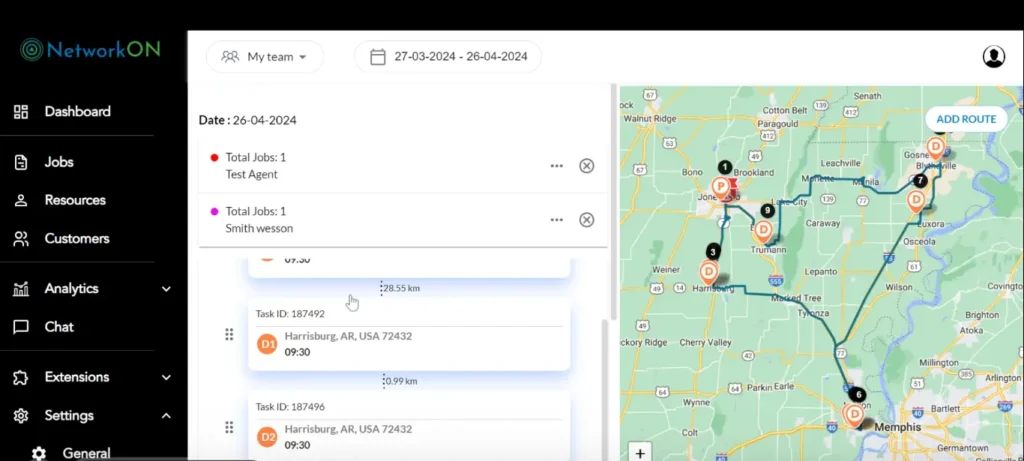Table of Contents
Within the realm of supply chain efficiency lies the central role freight management plays. Understanding this facet can transform logistics and streamline transportation processes to meet escalating demands. As businesses seek to balance the quality service and cost reduction equation, their strategies hinge on a meticulous understanding of the supply chain mechanism.

Effective freight management strategies become a keystone in enhancing service levels. Focusing on route optimization, cargo consolidation, and carrier selection has a ripple effect on delivery speed, reliability, and customer satisfaction. Achieving this equilibrium necessitates a multi-angled approach, integrating valuable insights from procurement, warehousing, distribution, and fulfillment to fortify the supply chain framework. Beyond the immediate benefits, injecting robust data analysis and real-time tracking technology into freight management is pivotal in preemptively identifying bottlenecks and crafting solutions that resonate with efficiency and economic advantage.
Transportation Management Systems (TMS) Unveiled
A Transportation Management System (TMS) stands at the heart of freight management, serving as the technological backbone that orchestrates the complex symphony of shipping and logistics activities. Employing sophisticated algorithms and vast datasets, a TMS oversees the movement of goods from origin to destination with precision and efficiency.
When integrated into Third-Party Logistics (3PL) operations, a TMS becomes more than software; it evolves into a transformative tool that yields numerous benefits. 3PL providers leveraging a TMS can expect enhanced shipment visibility, reduced freight costs, and route planning optimization. Furthermore, a TMS drastically improves the accuracy of freight billing and documentation, thereby minimizing delays and errors that could otherwise undermine customer relations and operational success.
Incorporating a TMS within shipment, transportation, and logistics management results in seamless coordination between all parties involved in the supply chain. Real-time data feed into the TMS enables dynamic decision-making that responds to shipping conditions, customer demands, or carrier availability changes. This leads to increased resource utilization, reduced idle fleet time, and an overall uptick in supply chain velocity.
- By automating routine processes, companies reduce administrative overhead.
- A comprehensive TMS analyzes various transport options, finding the most cost-effective and timely solutions.
- Moreover, a robust TMS minimizes the risk of human error, ensuring that regulatory compliance is maintained.
- Integration with other technologies, such as real-time tracking systems, supports predictive analytics and facilitates proactive management of potential disruptions.
- A TMS also plays a pivotal role in sustainability efforts by optimizing fuel efficiency routes and reducing logistics operations’ carbon footprint.
Enhancing Carrier Relationship Management
Building robust partnerships with carriers transcends simple business transactions. These alliances foster mutual growth and service enhancements, directly influencing the success of supply chain operations. Employ a multifaceted approach to solidify these pivotal relationships.
Strategies for Building Strong Carrier Partnerships
- Regularly discuss performance metrics to align with service expectations and identify areas for improvement.
- Engage in collaborative problem-solving to tackle challenges, emphasizing the shared benefits of a successful partnership.
- Recognize and reward carrier excellence, fostering a culture of appreciation and mutual respect.
The Impact of Good Carrier Relationships on Service Quality and Business Success
Positive carrier relationships enhance service quality, which is reflected in on-time delivery rates and load accuracy. These parameters significantly influence customer satisfaction. Moreover, carriers invested in the partnership are more likely to provide preferential treatment and capacity during peak demand.
Pro Tip: Transparent, structured communication ensures mutual understanding. Prioritize flexibility and fairness in contracts to meet both financial and operational needs.
Navigating Cost Reduction Strategies
To trim expenses within freight management, scrutinizing every aspect of the logistics process for savings opportunities turns up actionable insights. A granular review of operational components, such as route optimization and carrier efficiency, leads to substantive cost savings. Additionally, rationalizing the number of carriers and negotiating more favorable rates with existing ones reflects directly on the bottom line.
Identifying Areas Within Freight Management to Cut Costs
Every penny saved in freight management bolsters profitability. Employ strategies like load consolidation and off-peak shipping to decrease expenses. Pinpointing underperforming routes and replacing them with more cost-effective ones optimizes resource allocation and reduces costs.
The Role of Data Analytics in Reducing Business Expenses
Deploying data analytics surfaces hidden inefficiencies and unveils patterns that inform smarter spending decisions. By leveraging data, businesses detect outliers in transportation costs, ensuring that choices in freight management are driven by evidence rather than conjecture.
Assessing the Cost-Service Trade-off in Logistics Management
While reducing overhead is desirable, safeguarding service quality is equally imperative. Evaluating trade-offs facilitates informed decisions that align customer satisfaction with budgetary constraints. Deciphering the balance between cost and service ensures long-term customer retention and competitive advantage.
- Examine carrier contracts thoroughly to unearth negotiable terms.
- Integrate technology for route and load optimization to minimize wasted mileage.
- Apply just-in-time inventory to diminish holding costs without compromising supply.
The Edge of Real-time Tracking and Visibility

Real-time tracking and visibility stand at the forefront of contemporary freight management. With the more dynamic logistics landscape, detecting and disseminating immediate, actionable data defines successful shipping operations. Real-time data feeds decision-making processes, allowing businesses to respond with agility to unfolding situations on the ground.
Technologies Enabling Visibility Throughout the Supply Chain
Advancements in technology have opened the doors to unprecedented levels of supply chain transparency. GPS and RFID technologies, for instance, endow logistic partners with the means to track freight at every juncture. Integrating these technologies into supply chains ensures that each consignment reflects its accurate geo-location and status updates, catering to operational efficiency and security.
Sensors and IoT devices further facilitate a coarse view of the cargo environment. These devices monitor temperature, humidity, and handling, especially critical for perishable or fragile goods. Beyond tracking, cloud-based platforms harness this myriad of data streams, offering a centralized control tower perspective. Thus, stakeholders gain a panoramic view, encompassing the whereabouts and the condition of their goods in transit.
Addressing Customer Expectations with Better Tracking Systems
- By delivering granular details of shipment statuses, businesses cater to the modern customer’s demand for visibility and responsiveness. Customers no longer languish in the dark regarding their orders’ estimated arrival times.
- Advances in machine learning and predictive analytics further refine these tracking systems. Such technologies predict and communicate potential delays, allowing customers and businesses to plan accordingly.
- Enhanced tracking features foster customer satisfaction and nurture trust and loyalty. A transparent supply chain is a competitive edge in a market where consumers value information as much as they value the products they purchase.
Through real-time tracking and visibility, businesses witness the transformation of their supply chain into an accessible, infectious, and adaptable entity. Logistics partners leverage this visibility to execute strategic moves aligning with real-time insights, ensuring the supply chain operates harmoniously. The outcome: a resilient, responsive, and customer-centered freight management system.
Mitigating Risks in Freight Operations
Risks in freight management span numerous variables, from volatile market conditions to transportation’s inherent dangers. Identifying these potential issues paves the way for robust risk management processes.
Understanding the Issues and Respects Associated with Freight Management
Freight operations face various risks, including cargo theft, transportation delays, damage during transit, regulatory compliance issues, and environmental factors that can disrupt supply chains. To quantify and qualify the potential impacts, thorough risk assessments must be part of any freight management strategy.
Strategies to Manage and Mitigate Risk Effectively
- Implementing a sophisticated Transportation Management System (TMS) enables better control over logistics operations by optimizing route planning and load consolidation, thereby reducing exposure to transportation risks.
- Developing solid relationships with reliable carriers ensures that security and punctuality standards are met, directly influencing risk reduction.
- Diversifying the carrier base prevents dependency on a single service provider, spreading risk across multiple parties.
- Training personnel on risk awareness and management fortifies the human element in preventing and responding to unforeseen incidents.
- Real-time tracking technology enables proactive responses to potential disruptions in the supply chain. This allows for rerouting or expedited handling when delays are detected.
- Investing in contingency planning prepares organizations for exceptional circumstances, ensuring continuity of operations under various scenarios.
The Role of Insurance and Compliance in Risk Management
Insurance is indispensable in freight risk management, offering financial protection against losses from accidents, theft, or natural disasters. Adequate coverage is not a mere option but a critical component of any comprehensive freight management approach. Compliance with regulations, on the other hand, ensures that shipping practices adhere to international, federal, and local laws, thus averting fines, delays, and legal complications that can arise from non-compliant operations. Together, insurance and compliance create a fortified backbone defending against the risks that freight operations can encounter.
Revolutionizing Logistics with Cross-Docking
Cross-docking is at the heart of streamlining distribution, a practice that enables businesses to reduce warehousing steps and expedite the delivery process. By transferring incoming shipments directly to outbound trucks, companies see a decrease in handling times and storage costs. This immediacy in moving goods from receipt to shipment is a cornerstone of agile and efficient distribution strategies.
Strategically Integrating Cross-Docking into Your Logistics
Implementing cross-docking requires careful analysis of the types of products, frequency of shipments, and the overall impact on the supply chain velocity. Products that benefit from this tactic include perishable items needing swift delivery, high-demand products, or pre-tagged shipments for a specific destination. A crucial component for successful cross-docking is synchronization; supply chain partners must coordinate seamlessly to ensure the rapid movement of goods.
Optimizing Distribution for Superior Delivery Performance
To optimize distribution, warehouses must evolve into strategic hubs that prioritize the rapid flow of products. Leveraging advanced software systems, companies can gain real-time insight into freight movement, leading to better-informed decisions about routing and carrier selection. Performance metrics derived from these systems guide continuous improvement, culminating in enhancing delivery services and customer satisfaction.
- Advanced digital tools track freight from origin to destination, informing route optimization.
- Data-driven insights facilitate dynamic re-routing in response to unexpected events or changes.
- A deep understanding of distribution network functionality achieves efficient procurement and carrier negotiations.
Comprehending International Shipping Meeting Global Regulatory Standards
Keeping pace with international shipping regulations ensures seamless cross-border trade. Successful navigation of these complex rules requires a thorough understanding of the evolving landscape. Transporting goods internationally subject businesses to many guidelines that govern everything from packaging and labeling to tariffs and trade agreements.
Overview of International Shipping Regulations
Diverse authorities, such as the International Maritime Organization (IMO), World Customs Organization (WCO), and various national agencies, set international shipping standards. Regulations include the International Ship and Port Facility Security (ISPS) Code, the Safety of Life at Sea (SOLAS) Convention, and specific country customs requirements. Firms must meticulously adhere to these regulations to ensure lawful and secure shipments.
The Importance of Compliance for Global Business Operations
Acknowledging compliance in global business operations transcends avoiding legal repercussions; it preserves supply chain integrity. Adherence to global shipping norms reduces the risk of financial losses from penalties, cargo delays, and confiscations. Compliance fortifies reputation amongst peers and customers, facilitating business growth and operational continuity.
The Challenges of Keeping Up-to-Date with Changing Regulations
Regulatory landscapes are not static. They reflect shifts in international relations, environmental standards, and security concerns. Adaptation to ongoing changes is essential and mandates organizations to continually monitor updates. Procuring expert assistance or leveraging software solutions for compliance management automates the updating process, reduces errors, and aligns operations with current legal demands.
- Software solutions enhance compliance efficacy and accuracy.
- Expert consulting guarantees specialized attention to complex scenarios.
Propelling Warehouse Management to New Heights
Warehouse management serves as a cornerstone in the edifice of freight management, precisely aligning with logistics operations to ensure that the flow of goods is efficient and cost-effective. Rather than a mere storage point, warehouses function as dynamic hubs where products are actively managed to meet the demands of supply and demand. Strategic placement and sophisticated processes within these facilities considerably elevate the capability to serve consumers promptly and accurately.
Strategies for Streamlined Inventory Control
Optimizing inventory control is akin to a finely tuned symphony, where every note must be played at the right time and tempo. By implementing robust strategies such as just-in-time (JIT) inventory systems, companies can significantly trim excess stock and related holding costs. This approach demands precise forecasting and responsive logistics arrangements, enabling businesses to order goods only as needed. Another method, ABC analysis, segments inventory into categories based on importance and value, allowing managers to focus their resources and efforts where the biggest impact is felt.
Deploying Cutting-Edge Technological Solutions
Embracing technology fosters radical improvements in inventory oversight. Tools like Radio Frequency Identification (RFID) and barcode scanning automate data collection, reducing errors and accelerating throughput. Similarly, the advent of warehouse management systems (WMS) integrates real-time information flow across various channels, providing a transparent and actionable view of inventory levels. Advanced algorithms within these platforms also facilitate predictive analytics, enabling proactive resupply and optimal shelf allocation. As automation and robotics gain traction, the horizon of warehouse management widens further, introducing drones for inventory checks and automated guided vehicles (AGVs) to move goods.
- RFID tags can track products throughout the supply chain, enhancing security and efficiency.
- WMS platforms amalgamate multiple streams of data, ensuring labor and space within warehouses are utilized to their fullest potential.
- Automated solutions, from robots to software systems, promise greater accuracy and speed in inventory handling, reducing manual strain and maximizing productivity.
As businesses strive to satisfy an ever-expanding spectrum of consumer needs, they find warehouse optimization and state-of-the-art inventory control advantageous and necessary evolutions in freight management. These improvements envision and actualize a firm grasp of logistics excellence.
Overcoming E-commerce Fulfillment Challenges
As the e-commerce sector grows exponentially, logistics operations confront unique fulfillment challenges. Traditional supply chain models must evolve as customer expectations for rapid delivery skyrocket. Addressing the specific needs of e-commerce demands innovation at every step—from processing orders to the final delivery.
- E-commerce businesses face distinct challenges, such as high order volumes, the need for personalization, and an unrelenting pressure for speedy deliveries.
Scalability is a critical consideration, often determining the success or failure of e-commerce ventures. Managing an increase in orders, often during peak seasons, requires agile and scalable solutions.
The Role of Third-Party Logistics Providers (3PLs)
Third-party logistics providers (3PLs) bring expertise and infrastructure to the table, enhancing the e-commerce customer experience. They offer various services, including inventory management, order fulfillment, shipping optimization, and returns processing, which are essential for maintaining customer satisfaction.
3PLs deploy sophisticated logistics platforms that enable seamless integration with e-commerce businesses. These platforms allow for real-time updates, tracking, and inventory management. Utilizing a 3PL’s vast network can drastically reduce shipping times and costs while providing the scalability necessary during volume surges. There are multiple avenues through which e-commerce businesses can address fulfillment challenges. Successful adaptation involves understanding and integrating new logistics practices and developing strategic partnerships with technological and service experts. By doing so, e-commerce companies can deliver exceptional service quality, maintain customer loyalty, and drive growth.
Revolutionizing Returns: Mastering the Art of Reverse Logistics
Streamlining reverse logistics and returns management transforms the thorny process of handling returns into a seamless operation. Efficient reverse logistics recovers value from returned goods, ensures sustainable practices, and satisfies customers, reinforcing brand loyalty.
Challenges of Returns Management within Freight Operations
Striking a balance between cost-effective returns and customer satisfaction presents persistent challenges. Bulky items strain storage capacity and freight flow. Varied customer expectations necessitate adaptive strategies. Delays in processing can rapidly erode slim profit margins and tarnish brand reputation.
Joint efforts with supply chain partners create a fluid channel for returned merchandise, fortifying relationships and optimizing the logistics network. Such collaboration ensures resources concentrate on productive activities rather than managing disturbances caused by returns.
The Effect of Returns on Logistics and Inventory Control
Efficiently managed returns have a positive ripple effect on logistics and inventory control. Items reenter the supply chain swiftly, reducing the need for excess stock and minimizing lost sales. Accurate forecasting aligns inventory levels with demand, leading to more profitable operations.
Addressing the complexity of reverse logistics energizes the entire supply chain ecosystem. Companies rise to the challenge of providing exemplary service across all fronts, converting the potential setback of returns into an opportunity for improved operations and customer service excellence.
Tailoring Customized Logistics Solutions
Distinct challenges require unique solutions. In the sphere of freight management, one-size-fits-all answers do not suffice. By closely identifying and addressing specific freight management needs, businesses can uncover the potential for heightened efficiency and cost savings. Assessment of unique business circumstances yields insights critical for developing tailored strategies.
In contrast, a manufacturing firm with a stable but diverse product line may benefit from a different customized approach. By integrating cross-docking practices that streamline shipment and reduce handling time with a TMS that provides visibility across the supply chain, such a firm will achieve improved throughput and reduce inventory costs.
Another instance is an automotive parts supplier that required just-in-time delivery to multiple manufacturing locations. By developing a network optimization model, a tailored solution ensured timely delivery and significantly lower transport costs by consolidating shipments and optimizing carrier selection.
Building Flexibility and Adaptability into Logistics Offerings
Flexibility and adaptability are cornerstones of a robust logistics strategy. In today’s market, where change is the only constant, logistics providers must develop offerings that can quickly adapt to evolving business needs and global market shifts. Adaptability in logistics might involve agile contracts that allow for the scaling of transportation volumes or the ability to switch modes of transport seamlessly in response to disruptions.
Flexible solutions often leverage technology to aid in rapid decision-making. For instance, a dynamic routing system enables quick adjustments to transport routes in response to unexpected road conditions, thereby minimizing delivery delays and maintaining customer satisfaction.
Leveraging Data Analytics and Reporting in Freight
Data analytics and reporting transform freight management by informing strategic decision-making processes. With the explosive growth of big data, analytics now plays a critical role by making sense of large volumes of information to optimize operations. Accurate data analysis improves efficiency, cost savings, and customer service.
The Imperative of Data in Optimizing Freight Management
Comprehensive data analyses underpin successful freight management. Companies gain the insight required to streamline their operation by closely tracking performance metrics. This use of data eliminates inefficiencies and paves the way for enhanced supply chain agility.
Tools and Technologies That Enable Advanced Data Analysis
Modern tools and technologies are indispensable for parsing through data to unearth actionable insights. These tools range from advanced Transportation Management Systems, which integrate real-time data flows, to sophisticated algorithms and machine learning models that predict and optimize freight transit routes. Integrating these technologies into freight operations will streamline workflows and fortify the bottom line.
Leveraging analytics and reporting is not just about collecting data; it is about converting it into actionable insights. Advanced data analysis empowers organizations to anticipate market changes, respond to customer demand with agility, and sharpen their competitive edge. By utilizing data analytics and reporting, businesses stay ahead of trends, make informed decisions, and continue to innovate within the dynamic environment of freight management.
Key Takeaways:
Transportation Management Systems (TMS) Integration: TMS acts as a technological backbone, optimizing shipping and logistics activities through sophisticated algorithms and real-time data, resulting in enhanced shipment visibility, reduced freight costs, and improved route planning.
Carrier Relationship Management: Building robust partnerships with carriers through regular performance discussions, collaborative problem-solving, and recognizing excellence improves service quality, enhances on-time delivery rates, and fosters mutual growth.
Cost Reduction Strategies: Employing load consolidation, off-peak shipping, optimizing routes, and leveraging data analytics to identify inefficiencies that significantly reduce costs while maintaining service quality.
Real-time Tracking and Visibility: Utilizing GPS, RFID, sensors, and IoT devices provides real-time insights into freight location and condition, enabling dynamic decision-making, better customer satisfaction, and improved operational efficiency.
Sustainability and Warehouse Management: Investing in alternative fuel vehicles, measuring greenhouse gas emissions, and incorporating renewable energy in warehousing enhances environmental sustainability, while advanced technologies like RFID, WMS, and automation optimize inventory control and warehouse operations.
Conclusion
Facing the dynamic landscape of global logistics head-on, service providers must now more than ever refine their freight and transportation strategies. From the intricacies of a Transportation Management System (TMS) that propels efficiency to the delicate balance of carrier relationships that ensures the smooth movement of goods, every facet of the shipping world has been dissected to offer actionable insights.
Real-time tracking and risk mitigation are cornerstones in contemporary logistics management, providing the transparency and security businesses demand. Meanwhile, cross-docking and distribution tactics, alongside adept navigation of international shipping regulations, have been pinpointed as decisive factors for success in the industry.
The push towards sustainability and advanced warehouse management illustrates the shifting priorities in logistics, moving toward a model that blends efficiency with environmental consciousness. Addressing the complexities of e-commerce fulfillment has emerged as a critical need while overhauling reverse logistics systems signifies a holistic approach to the product lifecycle.
Data analytics has emerged as the backbone of logistics, guiding decision-makers through myriad business intelligence. Equally, the influence of technological advancements cannot be overlooked as they continue to revolutionize freight management practices. To those managing or partaking in third-party logistics, this comprehensive exploration arms you with the knowledge to assess, adapt, and excel. Harness these insights, reevaluate your current logistics strategies, and innovate to stay ahead of industry curves. Acknowledge the issues at hand and embrace the prospects for optimization.
Are you positioned to lead your business to new heights in freight management efficiency and service excellence? Reflect on these findings and join the dialogue to advance the industry. For deeper engagement or to explore customized strategies, contact NetworkON for a consultation tailored to your unique logistics management needs.
Frequently Asked Questions
What are the main benefits of implementing a Transportation Management System (TMS) in freight management?
A TMS provides enhanced shipment visibility, optimized route planning, reduced freight costs, and improved freight billing and documentation accuracy. It integrates real-time data, enabling dynamic decision-making and increasing overall supply chain efficiency and reliability.
How can businesses reduce costs in freight management without compromising service quality?
Businesses can reduce costs by employing load consolidation, off-peak shipping, optimizing routes, and rationalizing the number of carriers. Utilizing data analytics to uncover inefficiencies and negotiate favorable rates with carriers contributes to cost savings while maintaining high service standards.
Why is real-time tracking and visibility important in freight management?
Real-time tracking and visibility provide immediate insights into freight location and condition, allowing businesses to respond quickly to disruptions. This transparency enhances operational efficiency, reduces idle time, improves customer satisfaction by keeping them informed, and supports proactive management of potential issues.
How can companies ensure sustainability in their logistics operations?
Companies can enhance sustainability by investing in alternative fuel vehicles, using renewable energy sources in warehouses, measuring and reporting greenhouse gas emissions, and engaging in carbon offset programs. These initiatives not only reduce the environmental impact but also align with modern consumers’ increasing preference for environmentally responsible businesses.





0 Conversations